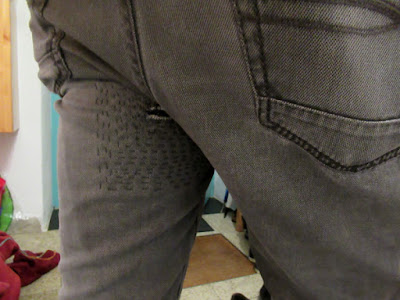Not that I had not ever mended a piece of clothing before, and I have written about little bits of mending before. But I wanted to run a sort of self-experiment based on this book as material of guidance before I started writing the review.
Luckily - for this purpose - one of the refugees happened to come along with a severe rip in one of his two pairs of jeans and asked whether that could be mended.
Under normal circumstances I might just have said, 'hey, let's go and buy a new pair' as they don't own much anyway and there is always bound to be a sale somewhere where you can pick up a pair of jeans for a good price. But this was a gift from somewhere and I asked him whether he would let me mend it for him, and might it be a bit crazier than he thought. Still thinking I could go and buy that new pair afterwards as well if he decided he was not pleased with my work.
So I studied closely what Katrina Rodabaugh lists as necessities, and started following her steps.
 |
| View from the inside at the same point in time: the patch had been attached as such on the outside, then the interior areas are being filled with mostly running stitch. |
Apart from the fact that the tips of my fingers started complaining at some point due to lack of sufficient practice and roughening with this kind of fabric, it was an easy mend.
 |
| The whole patch area has been filled with running stitch. If it had been a mend for myself I might have chosen red thread, buth I did not dare go so noticeable with a pair of pants that wasn't mine. |
 |
| Some additional stitches to fasten the edges of the rip and enforce the area of the patch that turned out visible in the rip. |
 |
| Completed mend. |
I liked it, but when I returned it to the owner I was a bit shy about his reaction to expect - I had told him it might be a bit of a noticeable mend, but of course he would not have know how far I would or could go. He trusts me, though, and said it was fine, and let me take a photo of the finished piece as he was wearing it.
Meanwhile I have gone to a local thrift store and bought a pair of jeans there in order to use that as a denim source. Neither my husband nor my son wear jeans, so there are no thriftable old pairs in the house when I want to start mending mine differently from ironing glue-on-patches onto the worn areas. Of course, with my jeans the first place to give up is the upper thigh area where the pants experience the most wear when riding the bike, which I do a lot in my everyday activities. The bike is my prime means of transportation in town.
The problem with my current favorite jeans, is, of course, that it got worn a lot, and that I did not start mending BEFORE the thin area broke. So now I have challenge ahead of me. Stay tuned - how much I will use of Katrina's techniques and add on to them with my own ideas, I don't know yet. But it is bound to happen sometime soon.







No comments:
Post a Comment